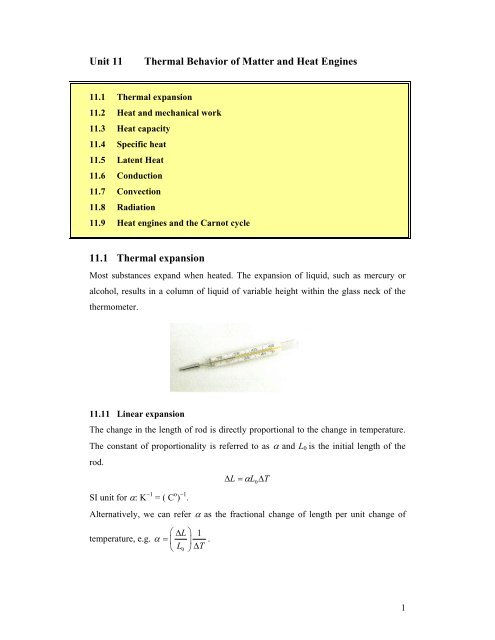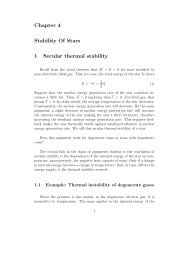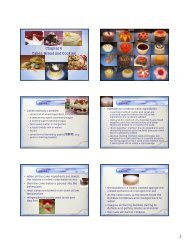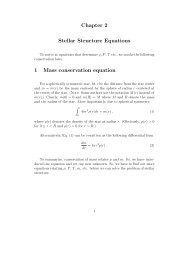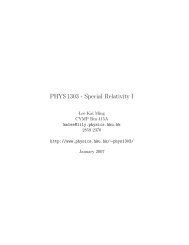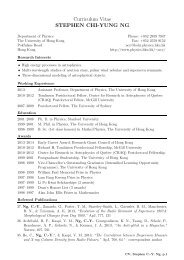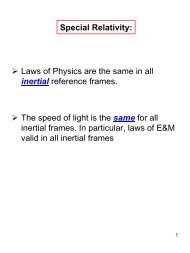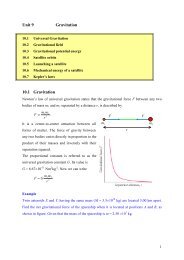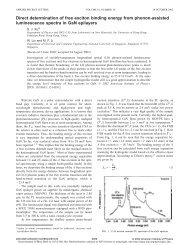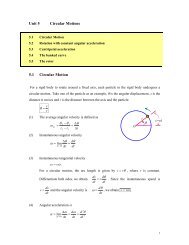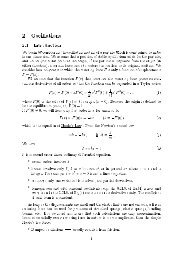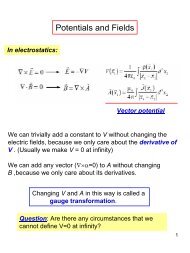Thermal Behavior of Matter and Heat Engines - Department of ...
Thermal Behavior of Matter and Heat Engines - Department of ...
Thermal Behavior of Matter and Heat Engines - Department of ...
You also want an ePaper? Increase the reach of your titles
YUMPU automatically turns print PDFs into web optimized ePapers that Google loves.
Unit 11<br />
<strong>Thermal</strong> <strong>Behavior</strong> <strong>of</strong> <strong>Matter</strong> <strong>and</strong> <strong>Heat</strong> <strong>Engines</strong><br />
11.1 <strong>Thermal</strong> expansion<br />
11.2 <strong>Heat</strong> <strong>and</strong> mechanical work<br />
11.3 <strong>Heat</strong> capacity<br />
11.4 Specific heat<br />
11.5 Latent <strong>Heat</strong><br />
11.6 Conduction<br />
11.7 Convection<br />
11.8 Radiation<br />
11.9 <strong>Heat</strong> engines <strong>and</strong> the Carnot cycle<br />
11.1 <strong>Thermal</strong> expansion<br />
Most substances exp<strong>and</strong> when heated. The expansion <strong>of</strong> liquid, such as mercury or<br />
alcohol, results in a column <strong>of</strong> liquid <strong>of</strong> variable height within the glass neck <strong>of</strong> the<br />
thermometer.<br />
11.11 Linear expansion<br />
The change in the length <strong>of</strong> rod is directly proportional to the change in temperature.<br />
The constant <strong>of</strong> proportionality is referred to as α <strong>and</strong> L 0 is the initial length <strong>of</strong> the<br />
rod.<br />
∆<br />
0<br />
L = α L ∆T<br />
SI unit for α: K −1 = ( C o ) −1 .<br />
Alternatively, we can refer α as the fractional change <strong>of</strong> length per unit change <strong>of</strong><br />
L 1<br />
temperature, e.g. α = ⎛ ⎜ ∆ ⎞<br />
⎟ .<br />
⎝ L0<br />
⎠ ∆ T<br />
1
Substance Coefficient <strong>of</strong> Expansion, α (K −1 )<br />
Lead<br />
Aluminum<br />
Copper<br />
Iron (Steel)<br />
Concrete<br />
Window glass<br />
Quartz<br />
29 × 10 −6<br />
24 × 10 −6<br />
17 × 10 −6<br />
12 × 10 −6<br />
12 × 10 −6<br />
11 × 10 −6<br />
0.50 × 10 −6<br />
Table: Coefficients <strong>of</strong> thermal expansion<br />
An interesting application <strong>of</strong> thermal expansion is in the behavior <strong>of</strong> a bimetallic strip.<br />
As the name suggests, a bimetallic strip consists <strong>of</strong> two metals bonded together to<br />
form a linear strip <strong>of</strong> metal. Since two different metals will, in general, have different<br />
coefficients <strong>of</strong> linear expansion, α, the two sides <strong>of</strong> the strip will change lengths by<br />
different amounts when heated or cooled. Refer to the figure.<br />
(a) A bimetallic strip composed <strong>of</strong> metals A <strong>and</strong> B. If metal B has a larger coefficient<br />
<strong>of</strong> linear expansion than metal A, it will shrink more when cooled (b), <strong>and</strong> exp<strong>and</strong><br />
more when heated (c). A bimetallic strip can be used to construct a thermostat (d). If<br />
the temperature falls, the strip bends downward <strong>and</strong> closes the electrical circuit, which<br />
then operates a heater. When the temperature rises, the strip deflects in the opposite<br />
direction, breaking the circuit <strong>and</strong> turning <strong>of</strong>f the heater.<br />
<strong>Thermal</strong> expansion, though small, is far from negligible in many everyday situations.<br />
This is especially true when long objects such as railroad tracks, bridges, or pipelines<br />
are involved. Bridges <strong>and</strong> elevated highways, must include expansion joints to<br />
prevent the roadway from buckling when it exp<strong>and</strong>s in hot weather. Similarly,<br />
2
pipelines typically include loops that allow for expansion <strong>and</strong> contraction when the<br />
temperature changes.<br />
11.12 Area expansion<br />
Since the length <strong>of</strong> an object changes with temperature, it follows that its area changes<br />
as well. The initial area <strong>of</strong> the square is A = L 2 . If the temperature <strong>of</strong> the square is<br />
changed by ∆T, <strong>and</strong> the length <strong>of</strong> each side <strong>of</strong> the square by ∆L,<br />
2<br />
2 2 2<br />
2 2 2<br />
A'<br />
= ( L + ∆L)<br />
= ( L + α L∆T<br />
) = ( L + 2αL<br />
∆T<br />
+ α L ∆T<br />
) .<br />
2 2<br />
Neglect the higher order term, e.g. α L ∆T<br />
2<br />
2<br />
, since α ∆T<br />
2<br />
relatively small, we have<br />
2 2<br />
A'<br />
= L + 2αL<br />
∆T<br />
= A + 2αA∆T<br />
That is<br />
∆A<br />
≈ 2 αA∆T<br />
.<br />
Though the calculation works out from square, it is applicable to area <strong>of</strong> any shape.<br />
Example<br />
A washer has hole in the middle. As the washer is heated, does the hole (a) exp<strong>and</strong>,<br />
(b) shrink, or (c) stay the same?<br />
3
Answer:<br />
To make a washer from a disk <strong>of</strong> metal, we can cut along a circular curve, <strong>and</strong> remove<br />
the inner disk. If we now heat the system, both the washer <strong>and</strong> the inner disk exp<strong>and</strong>.<br />
On the other h<strong>and</strong>, if we had left the inner disk in place <strong>and</strong> heated the original disk it<br />
would also exp<strong>and</strong>. Removing the heated inner disk would create an exp<strong>and</strong>ed<br />
washer, with an exp<strong>and</strong>ed hole in the middle. We obtain the same result whether we<br />
remove the inner disk <strong>and</strong> then heat, or heat first <strong>and</strong> then remove the inner disk.<br />
Thus, heating the washer causes both it <strong>and</strong> its hole to exp<strong>and</strong>, <strong>and</strong> they both exp<strong>and</strong><br />
with the same coefficient <strong>of</strong> linear expansion.<br />
11.13 Volume expansion<br />
Similar to the argument in the expansion <strong>of</strong> area with temperature, the volume<br />
changes with temperature. The initial volume <strong>of</strong> the cube is V = L 3 . If the temperature<br />
<strong>of</strong> the cube is changed by ∆T, <strong>and</strong> the length <strong>of</strong> each side <strong>of</strong> the cube by ∆L,<br />
3<br />
3 3 3<br />
2 3 2 3 3 3<br />
V ' = ( L + ∆L)<br />
= ( L + α L∆T<br />
) = ( L + 3αL<br />
∆T<br />
+ 3α<br />
L ∆T<br />
+ α L ∆T<br />
) .<br />
2 3 2<br />
3 3<br />
Neglect the higher order term, e.g. α L ∆T <strong>and</strong> α L ∆T<br />
3<br />
, we have<br />
3 3<br />
V ' = L + 3αL<br />
∆T<br />
= V + 3αV∆T<br />
That is<br />
∆V<br />
≈ 3 αV∆T<br />
.<br />
Though the calculation works out from cube, it is applicable to volume <strong>of</strong> any shape.<br />
We define the coefficient <strong>of</strong> volume expansion, β where ∆V<br />
≈ β V∆T<br />
, <strong>and</strong> β = 3α.<br />
Example<br />
A copper flask with a volume <strong>of</strong> 150 cm 3 is filled to the brim with olive oil. If the<br />
temperature <strong>of</strong> the system is increased from 6.0 o C to 31 o C, how much oil spills from<br />
the flask? The coefficient <strong>of</strong> expansion <strong>of</strong> olive oil is given as 0.69 × 10 −3 K −1 .<br />
<strong>Heat</strong> by 25 C o<br />
4
Answer:<br />
The change in temperature ∆T = 31 C o – 6 C o = 25 C o = 25 K.<br />
As the system is heated, both the flask <strong>and</strong> the oil exp<strong>and</strong>.<br />
The change in volume <strong>of</strong> the olive oil:<br />
The change in volume <strong>of</strong> the flask:<br />
∆V oil<br />
= βV∆T<br />
=<br />
=<br />
∆<br />
−3<br />
−1<br />
3<br />
3<br />
( 0.69×<br />
10 K )(150cm<br />
)(25 K)<br />
2.6cm<br />
V flask<br />
= βV∆T<br />
= 3αV∆T<br />
−6<br />
−1<br />
3<br />
= 3(17 × 10 K )(150cm<br />
)(25 K)<br />
=<br />
0.19cm<br />
3<br />
The difference in volume expansions is the volume <strong>of</strong> oil that spills out:<br />
3<br />
3<br />
3<br />
∆ Voil − ∆V<br />
flask<br />
= 2.6cm<br />
− 0.19cm<br />
= 2.4cm<br />
.<br />
11.2 <strong>Heat</strong> <strong>and</strong> mechanical work<br />
In this section we consider the connection between heat <strong>and</strong> mechanical work. We<br />
also discuss the conservation <strong>of</strong> energy as it regards heat. Recall that heat is the<br />
energy transferred from one object to another. The<br />
equivalence between work <strong>and</strong> heat was first explored<br />
quantitatively by James Prescott Joule (1818−1889), the<br />
British physicist. In one <strong>of</strong> his experiments, Joule<br />
observed the increase in temperature in a device similar to<br />
that shown in figure. Here, a mass m falls through a<br />
certain distance h, during which gravity does the<br />
mechanical work mgh. As the mass falls it turns the<br />
paddles in the water, which results in a slight warming <strong>of</strong> the water. By measuring the<br />
mechanical work, mgh, <strong>and</strong> the increase in the water’s temperature, ∆T, Joule was<br />
able to show that energy was indeed conserved. It had been converted from<br />
gravitational potential energy to heat, <strong>and</strong> an increased temperature.<br />
Before Joule’s work, heat was measured in a unit called the calorie (cal). In particular,<br />
one kilocalorie (kcal) was defined as the amount <strong>of</strong> heat needed to raise the<br />
temperature <strong>of</strong> 1 kg <strong>of</strong> water from 14.5 o C to 15.5 o C. With these experiments, Joule<br />
was able to show that 1 kcal = 4186 J, or equivalently, that one calorie is the<br />
5
equivalent <strong>of</strong> 4.186 J <strong>of</strong> mechanical work. This is referred to as the mechanical<br />
equivalent <strong>of</strong> heat:<br />
1 cal = 4.186 J.<br />
In studies <strong>of</strong> nutrition a different calorie is used. It is the Calorie, with a capital C,<br />
where 1 C = 1 kcal.<br />
Example<br />
A 74.0-kg person drinks a thick, rich, 305-C milkshake.<br />
How many stairs must this person climb to work <strong>of</strong>f the<br />
shake? Let the height <strong>of</strong> a stair be 20.0 cm.<br />
Answer:<br />
We should first convert the energy <strong>of</strong> the milkshake to joules:<br />
⎛ 4.186 J ⎞<br />
6<br />
Q = 305 ,000cal<br />
= 305,000cal<br />
⎜ = 1.28×<br />
10 J<br />
1 cal<br />
⎟<br />
.<br />
⎝ ⎠<br />
To consume the milkshake, the work done against gravity = Q = mgH, where H is the<br />
6<br />
Q 1.28×<br />
10 J<br />
height <strong>of</strong> stairs. The height H is given by H = =<br />
= 1763m<br />
.<br />
2<br />
mg (74.0 kg)(9.81m<br />
/ s )<br />
The number <strong>of</strong> stairs is obtained:<br />
1760m = 8815 stairs .<br />
0.200m<br />
11.3 <strong>Heat</strong> capacity<br />
Suppose we add the heat Q to a given object, <strong>and</strong> its temperature increases by the<br />
amount ∆T. The heat capacity, C in this object is defined as follow:<br />
Q<br />
C = ∆ T<br />
The heat capacity C has SI unit: J/K = J/C o .<br />
Note that,<br />
Q is positive if ∆T, is positive; that is, if heat is added to a system.<br />
Q is negative if ∆T, is negative; that is, if heat is removed from a system.<br />
6
Example<br />
The heat capacity <strong>of</strong> 1.00 kg <strong>of</strong> water is 4186 J/K. What is the temperature change <strong>of</strong><br />
the water if (a) 505 J <strong>of</strong> heat is added to the system, or (b) 1010 J <strong>of</strong> heat is removed?<br />
Answer:<br />
(a) We calculate the ∆T for Q = 505 J.<br />
Q 505 J<br />
∆ T = = = 0. 121K<br />
.<br />
C 4186 J / K<br />
(b)<br />
Since heat is removed from the system, <strong>and</strong> Q = −1010 J, the change in<br />
temperature ∆T:<br />
Q −1010<br />
J<br />
∆ T = = = −0.<br />
241K<br />
.<br />
C 4186 J / K<br />
11.4 Specific heat<br />
Since heat capacity varies with the amount <strong>of</strong> substance, even the substances are <strong>of</strong><br />
the same type. A new quantity, the specific heat, c, is then defined. The specific heat<br />
depends on the substance, <strong>and</strong> not on the amount <strong>of</strong> the substance.<br />
Q<br />
c =<br />
m∆T<br />
The specific heat c has SI unit: J/(kg⋅K) = J/(kg⋅C o ).<br />
For example the specific heat <strong>of</strong> water is<br />
c water<br />
= 4186 J /( kg ⋅ K)<br />
.<br />
Specific heats for common substances are listed in table. Note that the specific heat <strong>of</strong><br />
water is by far the largest <strong>of</strong> any common material. This is just another <strong>of</strong> the many<br />
unusual properties <strong>of</strong> water. Having such a large specific heat means that water can<br />
give <strong>of</strong>f or take in large quantities <strong>of</strong> heat with little change in temperature. It is for<br />
this reason that if you bite a pie that is just out the oven, you are much more likely to<br />
burn you tongue on the fruit filling (which has a high water content) than on the much<br />
drier crust.<br />
7
Substance<br />
Specific heat, c, [J/(kg⋅K)]<br />
Water 4186<br />
Ice 2090<br />
Steam 2010<br />
Aluminum 900<br />
Glass 703<br />
Iron (steel) 448<br />
Copper 387<br />
Silver 234<br />
Gold 129<br />
Lead 128<br />
Table: Specific heats at atmospheric temperature <strong>and</strong> pressure<br />
Example<br />
550 g <strong>of</strong> water at 32 o C is poured into a 210-g aluminum can with an initial<br />
temperature <strong>of</strong> 15 o C. Find the final temperature <strong>of</strong> the system, assuming no heat is<br />
exchanged with the surroundings.<br />
Answer:<br />
Method 1:<br />
The heat flow out <strong>of</strong> water: Q = m c ( T − T ) .<br />
The heat flow into the aluminum: Q = m c T − T ) .<br />
W<br />
W<br />
a<br />
W<br />
W<br />
a a<br />
(<br />
a<br />
Conservation <strong>of</strong> energy implies<br />
Q = Q , which gives T = 31 o C.<br />
W<br />
a<br />
Method 2:<br />
The heat flow out <strong>of</strong> water: Q = m c T − T ) .<br />
W<br />
W<br />
W<br />
(<br />
W<br />
The heat flow into the aluminum: Q = m c T − T ) .<br />
a<br />
a a<br />
(<br />
a<br />
Conservation <strong>of</strong> energy implies Q Q = 0 , which gives T = 31 o C.<br />
W<br />
+ a<br />
8
11.5 Latent heats<br />
The latent heat, L, is the heat that must be added to or removed from one kilogram <strong>of</strong><br />
a substance to convert it from one phase to another. During the conversion process,<br />
the temperature <strong>of</strong> the system remains constant. Latent heat is a positive quantity.<br />
Mathematically, Q = mL, where the SI unit <strong>of</strong> L is J/kg. The latent heat to melt a<br />
substance is referred to as the latent heat <strong>of</strong> fusion, L f . The latent heat required to<br />
convert a liquid to a gas is the latent heat <strong>of</strong> vaporization, L v . The latent heat needed to<br />
convert a solid directly to a gas is the latent heat <strong>of</strong> sublimation, L s .<br />
Material Latent heat <strong>of</strong> fusion (J/kg) Latent heat <strong>of</strong> vaporization (J/kg)<br />
Water 33.5 × 10 4 22.6× 10 5<br />
Ammonia 33.2 × 10 4 13.7× 10 5<br />
Copper 20.7 × 10 4 47.3× 10 5<br />
Ethyl alcohol 10.8 × 10 4 8.55× 10 5<br />
Gold 6.28 × 10 4 17.2× 10 5<br />
Nitrogen 2.57 × 10 4 2.00× 10 5<br />
Lead 2.32 × 10 4 8.59× 10 5<br />
Oxygen 1.39 × 10 4 2.13× 10 5<br />
Example<br />
Both water at 100 o C <strong>and</strong> steam at 100 o C can cause serious burn. Is a burn produced<br />
by steam likely to be (a) more severe, (b) less severe, or (c) the same as a burn<br />
produced by water?<br />
9
Answer:<br />
As the water or steam comes into contact with skin, it cools down to the temperature<br />
<strong>of</strong> skin, e.g. 39 o C. For the case <strong>of</strong> steam, it needs to cool down to 100 o C water first<br />
<strong>and</strong> then further cool down to 39 o C. That means, the body skin absorb more heat from<br />
the steam than water, <strong>and</strong> the steam burn is worse.<br />
11.5 Conduction<br />
Perhaps the most familiar form <strong>of</strong> heat exchange is conduction, which is the flow <strong>of</strong><br />
heat directly through a physical material. For example, if you hold one end <strong>of</strong> a metal<br />
rod <strong>and</strong> put the other end in a fire, it doesn’t take long before you begin to feel<br />
warmth on your end. The heat you feel is transported along the rod by conduction. In<br />
microscopic point <strong>of</strong> view, when you placed one end <strong>of</strong> the<br />
rod into the fire the high temperature at that location caused<br />
the molecules to vibrate with an increased amplitude. These<br />
molecules in turn jostle their neighbors, <strong>and</strong> cause them to<br />
vibrate with greater amplitude as well. Eventually the effect<br />
travels from molecule to molecule across the length <strong>of</strong> the<br />
rod, resulting in the macroscopic phenomenon <strong>of</strong> conduction.<br />
Consider now, how much heat flows as a result <strong>of</strong> conduction? To answer this<br />
question we consider the simple system. Here we show a rod <strong>of</strong> length L <strong>and</strong> crosssectional<br />
area A, with one end at the temperature T 1 <strong>and</strong> the other at the temperature<br />
T 2 > T 1 . Experiments show that the amount <strong>of</strong> heat Q that flows through this rod:<br />
Increases in proportion to the rod’s cross-sectional area, A;<br />
Increases in proportion to the temperature difference, ∆ T = T 2<br />
− T1<br />
;<br />
Increases steadily with time, t;<br />
Decreases with the length <strong>of</strong> the rod, L.<br />
Combining these observations in a mathematical expression gives:<br />
⎛ ∆T<br />
⎞<br />
Q = kA⎜<br />
⎟t<br />
.<br />
⎝ L ⎠<br />
The constant k is referred to as the thermal conductivity <strong>of</strong> the rod.<br />
10
Substance<br />
<strong>Thermal</strong> conductivity, k, [W/(m⋅K)]<br />
Silver 417<br />
Copper 395<br />
Gold 291<br />
Aluminum 217<br />
Steel, low carbon 66.9<br />
Lead 34.3<br />
Stainless steel 16.3<br />
Ice 1.6<br />
Concrete 1.3<br />
Glass 0.84<br />
Water 0.60<br />
Wood 0.10<br />
Wool 0.040<br />
Air 0.0234<br />
Table: <strong>Thermal</strong> conductivities<br />
Example<br />
One <strong>of</strong> the windows in a house has the shape <strong>of</strong> a square 1.0 m on<br />
a side. The glass in the window is 0.50 cm thick. How much heat<br />
is lost through this window in one day if the temperature in the<br />
house is 21 o C <strong>and</strong> the temperature outside is 0.0 o C?<br />
Answer:<br />
Since the thermal conductivity <strong>of</strong> glass is 0.84 W/(m⋅K) <strong>and</strong> the<br />
⎛ ∆T<br />
⎞<br />
formula for heat flow is Q = kA⎜<br />
⎟t<br />
, hence,<br />
⎝ L ⎠<br />
2 ⎛ 21K<br />
⎞<br />
8<br />
Q = [ 0.84W<br />
/( m ⋅ K)](1.0<br />
m)<br />
⎜ (24 × 60 × 60 s)<br />
= 3.0 × 10 J<br />
0.0050 m<br />
⎟<br />
.<br />
⎝ ⎠<br />
11
Example<br />
Two metal rods are to be used to conduct<br />
heat from a region <strong>of</strong> 100 o C to a region<br />
at 0 o C. The rods can be placed in<br />
parallel, as shown in figure. Is the heat<br />
conducted in the parallel arrangement (a)<br />
greater than, (b) less than, or (c) the same as the heat conducted with the rods in<br />
series?<br />
Answer:<br />
The parallel arrangement conducts more heat for two reasons.<br />
(i) The cross-sectional area available for heat flow is twice as large for the<br />
parallel rods.<br />
(ii) The parallel configuration has both rods the full temperature difference.<br />
Example<br />
Two 0.525-m rods, one lead the other copper, are<br />
connected between metal plates held at 2.00 o C <strong>and</strong><br />
106 o C. The rods have a square cross section, 1.50<br />
cm on a side. How much heat flows through the<br />
two rods in 1.00 s? Assume that no heat is<br />
exchanged between the rods <strong>and</strong> the surroundings, except at the ends.<br />
Answer:<br />
The heat flow in one second through the lead rod:<br />
Q<br />
l<br />
⎛ ∆T<br />
⎞<br />
= kl<br />
A⎜<br />
⎟t<br />
⎝ L ⎠<br />
2<br />
⎛ 104 K ⎞<br />
= [34.3W<br />
/( m ⋅ K)](0.0150<br />
m)<br />
⎜ (1.00 s)<br />
0.525m<br />
⎟<br />
⎝ ⎠<br />
= 1.53 J<br />
The heat flow in one second through the copper rod:<br />
12
Q<br />
c<br />
⎛ ∆T<br />
⎞<br />
= kc<br />
A⎜<br />
⎟t<br />
⎝ L ⎠<br />
= [395W<br />
/( m ⋅ K)](0.0150m)<br />
= 17.6 J<br />
2<br />
⎛ 104 K ⎞<br />
⎜ (1.00 s)<br />
0.525m<br />
⎟<br />
⎝ ⎠<br />
Total heat flow in one second:<br />
Q + Q<br />
= 1 .53 J + 17.6 J = 19.<br />
l c<br />
1<br />
J<br />
Example<br />
The two rods in the above example is arranged in series.<br />
Find (a) the temperature at the lead-copper junction, <strong>and</strong> (b)<br />
the amount <strong>of</strong> heat that flows through the rods in 1.00 s.<br />
Assume that no heat is exchanged between the rods <strong>and</strong> the<br />
surroundings, except at the ends.<br />
Answer:<br />
(a) Let the temperature at the lead-copper junction be T.<br />
The heat flow through the lead rod:<br />
The heat flow through the copper rod:<br />
Q<br />
l<br />
Q<br />
c<br />
⎛ T − 2.00<br />
= kl<br />
A<br />
⎜<br />
⎝ L<br />
C<br />
⎟ ⎞<br />
t .<br />
⎠<br />
o<br />
⎛106<br />
C − T<br />
kc<br />
A<br />
t<br />
L ⎟ ⎞<br />
=<br />
⎜<br />
.<br />
⎝ ⎠<br />
Since the heat flow in the lead equal to the heat flow in the copper.<br />
o<br />
o<br />
⎛ T − 2.00 C ⎞ ⎛106<br />
C − T<br />
kl<br />
A<br />
t kc<br />
A<br />
t<br />
L<br />
L ⎟ ⎞<br />
⎜<br />
⎟ =<br />
⎜<br />
⎝<br />
⎠ ⎝ ⎠<br />
o<br />
o<br />
We have k ( T − 2.00 C)<br />
= k (106 C − T ) , hence<br />
l<br />
c<br />
o<br />
o<br />
(106 C)<br />
kc<br />
+ (2.00 C)<br />
kl<br />
o<br />
T = = 97.7 C .<br />
k + k<br />
c<br />
l<br />
(b) We substitute T into the formula <strong>of</strong> heat flow for each rod. Note that the time<br />
interval we are going to calculate is one second (i.e. t = 1 s)<br />
o<br />
Lead:<br />
o<br />
⎛ T − 2.00 C ⎞<br />
Ql = kl<br />
A<br />
⎜<br />
t = 1. 41J<br />
L<br />
⎟<br />
⎝<br />
⎠<br />
13
o<br />
⎛106<br />
C − T ⎞<br />
Copper: Qc = kc<br />
A<br />
⎜<br />
t = 1. 41J<br />
L<br />
⎟<br />
⎝ ⎠<br />
The heat flow in this series arrangement in one second is 1.41 J. Note also that the<br />
heat flow through the rods in series, 1.41 J, is much less than the heat flow through<br />
the rods in parallel, 19.1 J. This confirms our conclusion in the last example.<br />
11.6 Convection<br />
Suppose you want to heat a small room. To do so, you<br />
bring a portable electric heater into the room <strong>and</strong> turn it<br />
on. As the heating coils get red-hot they heat the air in<br />
their vicinity, <strong>and</strong> as this air warms, it exp<strong>and</strong>s, becoming<br />
less dense. Because <strong>of</strong> its lower density, the warm air<br />
rises, to be replaced by cold dense air descending from<br />
overhead. This sets up a circulating flow <strong>of</strong> air that<br />
transports heat from the heating coils to the air throughout<br />
the room. <strong>Heat</strong> exchange <strong>of</strong> this type is referred to as<br />
convection.<br />
In general, convection occurs when a fluid is unevenly<br />
heated. As with the room heater, the warm portions <strong>of</strong> the<br />
fluid rise because <strong>of</strong> their lower density <strong>and</strong> cool portions sink because <strong>of</strong> their higher<br />
density. Thus, in convection, temperature differences result in a flow <strong>of</strong> fluid. It is this<br />
physical flow <strong>of</strong> matter that carries heat throughout the system.<br />
Alternating l<strong>and</strong> <strong>and</strong> sea breezes are example <strong>of</strong> convection in the atmosphere. Refer<br />
to the figures. (a) During the day, the sun warms the l<strong>and</strong> more rapidly than the water.<br />
This is because the l<strong>and</strong>, which is mostly rocks, has a lower specific heat than the<br />
water. The warm l<strong>and</strong> heats the air above it, which becomes less dense <strong>and</strong> rises.<br />
Cooler air from over the water flows in to take its place, producing a “sea breeze”. (b)<br />
At night, the l<strong>and</strong> cools <strong>of</strong>f more rapidly than the water – again because <strong>of</strong> its lower<br />
specific heat. Now it is the air above the relatively warm water that rises <strong>and</strong> is<br />
replaced by cooler air from over the l<strong>and</strong>, producing a “l<strong>and</strong> breeze”.<br />
14
11.7 Radiation<br />
All objects give <strong>of</strong>f energy as a result <strong>of</strong> radiation. The energy radiated by an object is<br />
in the form <strong>of</strong> electromagnetic waves, which include visible light as well as infrared<br />
<strong>and</strong> ultraviolet radiation. Thus, unlike convection <strong>and</strong> conduction, radiation has no<br />
need for a physical material to mediate the energy transfer, since electromagnetic<br />
waves can propagate through empty space – that is, through a vacuum.<br />
The energy radiated per time by an object – that is, the radiated power, P – is<br />
proportional to the surface area, A, over the radiation occurs. It also depends on the<br />
temperature <strong>of</strong> the object. This behavior is described in the Stefan-Boltzmann law:<br />
P = eσAT<br />
SI unit <strong>of</strong> power is W, the Watt.<br />
The constant σ in this expression is a fundamental physical constant, the Stefan-<br />
Boltzmann constant:<br />
−8<br />
2 4<br />
σ = 5.67 × 10 W /( m ⋅ K ) .<br />
The other constant is the emissivity, e. It is a dimensionless number between 0 <strong>and</strong> 1<br />
that indicates how effective the object is in radiating energy. A value <strong>of</strong> 1 means that<br />
the object is a perfect radiator.<br />
Experiments show that objects absorb radiation from their surroundings according to<br />
the same law, the Stefan-Boltzmann law, by which they emit radiation. Thus, if the<br />
temperature <strong>of</strong> an object is T, <strong>and</strong> its surroundings are at the temperature T s , the net<br />
power radiated by the object is<br />
P<br />
4 4<br />
= eσ A(<br />
T − ) .<br />
net<br />
T s<br />
4<br />
Example<br />
A man has his surface area <strong>of</strong> skin 1.15 m 2 <strong>and</strong> a surface<br />
temperature 303 K. Find the net radiated power from<br />
this person (a) in a dressing room where the temperature<br />
is 293 K, <strong>and</strong> (b) outside, where the temperature is 273<br />
K. Assume an emissivity <strong>of</strong> 0.900 for the person’s skin.<br />
15
Answer:<br />
(a) In the dressing room:<br />
P<br />
net<br />
= eσA(<br />
T<br />
4<br />
− T<br />
4<br />
s<br />
= (0.900)[5.67 × 10<br />
)<br />
−8<br />
W /( m<br />
2<br />
⋅ K<br />
4<br />
2<br />
)](1.15m<br />
) × [(303 K)<br />
4<br />
− (293 K)<br />
4<br />
] = 62.1W<br />
(b)<br />
P<br />
net<br />
In the outdoor:<br />
= eσA(<br />
T<br />
4<br />
− T<br />
4<br />
s<br />
= (0.900)[5.67 × 10<br />
)<br />
−8<br />
W /( m<br />
2<br />
⋅ K<br />
4<br />
2<br />
)](1.15m<br />
) × [(303 K)<br />
4<br />
− (273 K)<br />
4<br />
] = 169W<br />
In the warm room the net radiated power is roughly that <strong>of</strong> a small lightbulb (about 60<br />
W); outdoors the net radiated power has more than doubled, <strong>and</strong> is comparable to that<br />
<strong>of</strong> a 150-W lightbulb.<br />
11.9 <strong>Heat</strong> engines <strong>and</strong> the Carnot cycle<br />
A heat engine is a device that converts heat into work. The classic example <strong>of</strong> this<br />
type <strong>of</strong> device is steam engine. The basic elements <strong>of</strong> a steam engine are a boiler,<br />
where heat converts water to steam, <strong>and</strong> a<br />
piston that can be displaced by the<br />
exp<strong>and</strong>ing steam. In some engines, the<br />
steam is simply exhausted into the<br />
atmosphere after it has exp<strong>and</strong>ed against<br />
the piston. More sophisticated engines<br />
send the exhaust steam to a condenser,<br />
where it is cooled <strong>and</strong> condensed back to<br />
liquid water, then recycled to the boiler.<br />
<strong>Heat</strong> engines have in common are:<br />
(i) A high temperature region, or reservoir,<br />
that supplies heat to the engine (the boiler<br />
in the steam engine);<br />
(ii) A low temperature reservoir where<br />
“waste” heat is released (the condenser in<br />
the steam engine); <strong>and</strong><br />
(iii) An engine that operates in a cycle fashion.<br />
16
In addition, though not shown in the figure, heat engines have a working substance<br />
(steam in the steam engine) that causes the engine to operate.<br />
Notice that a certain amount <strong>of</strong> heat, Q h , is supplied to the engine from the high<br />
temperature or “hot” reservoir. Of this heat, a fraction appears as work, W, <strong>and</strong> the<br />
rest is given <strong>of</strong>f as waste heat, Q c , at a relatively low temperature to the “cold”<br />
reservoir. Let Q h <strong>and</strong> Q c denote magnitudes, so that both quantities are positive,<br />
energy conservation can be written as follows: W<br />
= Q h<br />
− Q .<br />
Of particular interest for any engine is its efficiency, e, which is simply the fraction <strong>of</strong><br />
the heat supplied to the engine that appears as work.<br />
W<br />
e = .<br />
Q h<br />
We have also the relations<br />
e<br />
W<br />
Q<br />
− Q<br />
Q<br />
h c<br />
c<br />
= = = 1 − .<br />
Qh<br />
Qh<br />
Qh<br />
The unit <strong>of</strong> e is dimensionless. Lord Kelvin suggested that the ratio <strong>of</strong> heats (Q h <strong>and</strong><br />
Qc), <strong>and</strong> temperatures (T h , T c ) for an engine <strong>of</strong> maximum efficiency e max are related<br />
by the formula<br />
Q<br />
c<br />
T =<br />
c , which is also known as the Carnot relation. The maximum<br />
Q<br />
h<br />
T<br />
h<br />
Tc<br />
efficiency <strong>of</strong> a heat engine is rewritten as emax = 1− .<br />
T<br />
Example<br />
Suppose you have a heat engine that can operate in one <strong>of</strong> the two different modes. In<br />
mode 1, the temperatures <strong>of</strong> the two reservoirs are T c = 200 K <strong>and</strong> T h = 400 K; in<br />
mode 2, the temperatures are T c = 400 K <strong>and</strong> T h = 600 K. Is the efficiency <strong>of</strong> mode 1<br />
(a) greater than, (b) less than, or (c) equal to the efficiency <strong>of</strong> mode 2?<br />
h<br />
c<br />
Answer:<br />
Tc<br />
The efficiency depends on the ratio <strong>of</strong> the two temperatures, e = 1 − rather than on<br />
T<br />
1 1<br />
their difference. In this case, the efficiency <strong>of</strong> mode 1 is e<br />
1<br />
= 1−<br />
= <strong>and</strong> the<br />
2 2<br />
efficiency <strong>of</strong> mode 2 is e<br />
2<br />
= 1−<br />
3<br />
2<br />
=<br />
lower temperatures, is more efficient.<br />
1<br />
. Thus, mode 1, even though it operates at the<br />
3<br />
h<br />
17
When we stated the second law <strong>of</strong> thermodynamics,<br />
we said that the spontaneous flow <strong>of</strong> heat is always<br />
from high temperature to low temperature. The key<br />
word here is “spontaneous”. It is possible for heat to<br />
flow “uphill”, from a cold object to a hot one, but it<br />
doesn’t happen spontaneously - work must be done<br />
on the system to make it happen, just as work must<br />
be done to pump water from a well. Refrigerators, air<br />
conditioners, heat pumps are devices that use work<br />
to make heat flow against its natural tendency.<br />
By energy conservation, we have Q<br />
= Q W .<br />
h c<br />
+<br />
We define the coefficient <strong>of</strong> performance, COP, for a<br />
refrigerator as an indicator <strong>of</strong> its effectiveness:<br />
Qc<br />
COP = .<br />
W<br />
Typical values for COP are in the range 2 to 6.<br />
A heat pump can be considered as an air conditioner with the reservoirs switched. A<br />
heat pump does a work W to remove an amount <strong>of</strong> heat from the cold reservoir <strong>of</strong><br />
outdoor air, then exhausts a heat Q h into the hot reservoir <strong>of</strong> air in the room. Just as<br />
with the refrigerator <strong>and</strong> the air conditioner, the heat going to the hot reservoir is<br />
Q<br />
= Q W .<br />
h c<br />
+<br />
In an ideal, reversible heat pump, we have<br />
Q<br />
c<br />
T =<br />
c holds, just as it does for a heat<br />
engine. Thus, if you want to add a heat Q h to a room, the work that must be done to<br />
accomplish this is<br />
⎛ Q ⎞ ⎛ ⎞<br />
= − =<br />
⎜ −<br />
c<br />
T<br />
⎟ =<br />
⎜ −<br />
c<br />
W Q<br />
⎟<br />
h<br />
Qc<br />
Qh<br />
1 Qh<br />
1 .<br />
⎝ Qh<br />
⎠ ⎝ Th<br />
⎠<br />
Example<br />
An ideal heat pump, one that satisfies the Carnot relation, is used to heat a room that<br />
is at 293 K. If the pump does 275 J <strong>of</strong> work, how much heat does it supply to the<br />
room if the outdoor temperature is (a) 273 K or (b) 263 K?<br />
Q<br />
h<br />
T<br />
h<br />
18
Answer:<br />
(a) Since W<br />
⎛ T ⎞<br />
= ⎜ −<br />
c<br />
Q<br />
⎟<br />
h<br />
1 , we have<br />
⎝ Th<br />
⎠<br />
W 275 J<br />
Qh = =<br />
= 4030 J .<br />
⎛ Tc<br />
⎞ ⎛ 273 K ⎞<br />
⎜1<br />
− 1<br />
T<br />
⎟<br />
⎜ −<br />
h<br />
293 K<br />
⎟<br />
⎝ ⎠ ⎝ ⎠<br />
(b) Similarly, we have<br />
W 275 J<br />
Qh = =<br />
= 2690 J .<br />
⎛ Tc<br />
⎞ ⎛ 263K<br />
⎞<br />
⎜1<br />
− 1<br />
T<br />
⎟<br />
⎜ −<br />
h<br />
293K<br />
⎟<br />
⎝ ⎠ ⎝ ⎠<br />
As one might expect, the same amount <strong>of</strong> work provides less heat<br />
when the outside temperature is lower. That is, more work must be done on a colder<br />
day to provide the same heat to the inside air.<br />
19


